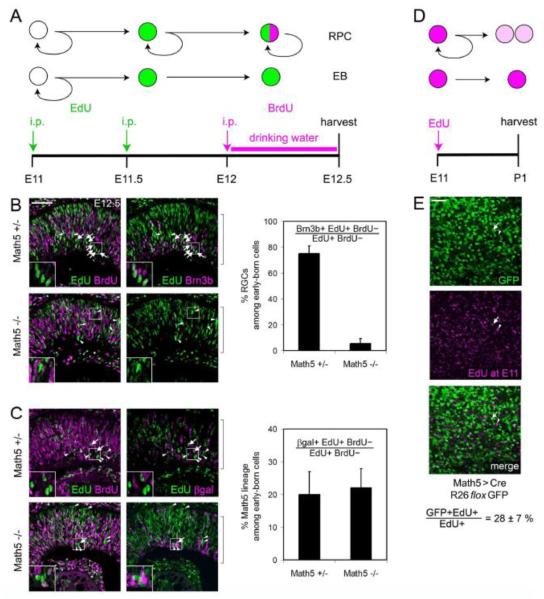Fig. 6.
Math5 marks many of the earliest born cells in the retina. (A-C) Window labeling analysis. (A) Embryos were exposed to pulses of EdU at E11 (onset of neurogenesis) and E11.5, and to continuous BrdU from E12 to E12.5. Progenitors (RPCs) that continue to cycle through E12.5 are EdU+ BrdU+, while cells that have exited mitosis between E11 and E12 are EdU+ BrdU-, and represent the earliest born cohort of retinal neurons. (B-C) Sections through the neural retina (brackets). (B) Most early-born cells in Math5 +/− mice adopt RGC fate (EdU+ BrdU-Brn3b+, arrows). The Brn3b-cells in this cohort are likely to include horizontal cell precursors (arrowheads). Few Brn3b+ RGCs (arrows) are present in Math5 −/− embryos, and the abundance of non-RGC fates increases accordingly (arrowheads). (C) Early-born Math5-lacZ (EdU+ BrdU-βgal+, arrows) and βgal− (arrowheads) cells are shown in Math5 +/− (top) and Math5 −/− (bottom) mice. Only ~20% of the early-born cohort expresses the Math5 transcription unit (βgal+), in both genotypes. (D-E) Birthdating analysis. (D) E11 Math5>Cre; R26floxGFP embryos were exposed to a single EdU injection and analyzed at P1. (E) Flatmounted retinas were stained for EdU and GFP and imaged through the GCL. Strongly EdU+ cells mark the earliest born retinal neurons. Confocal projection image (6-10 μm) shows EdU+ GFP+ (arrow) and EdU+ GFP− (arrowhead) cells. Only 28% of the GCL cells born at E11 are in the Math5+ lineage. i.p., intraperitoneal; EB, early-born. Error bars represent the binomial standard deviation. Scale bar, 50 m.

